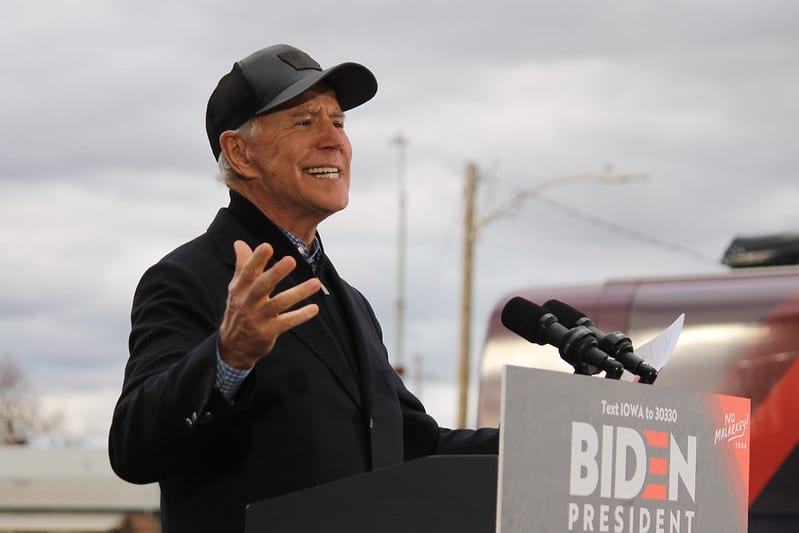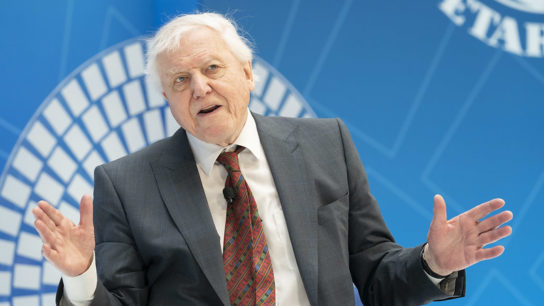At the start of the Climate Leaders’ Summit hosted by US President Joe Biden on April 22, he pledged to cut US emissions by 50% by 2030 from 2005 levels, with the aim to reach zero emissions by 2050. This is the most ambitious climate goal yet by an American leader. What else has he pledged and how does it stack up?
—
What is Happening?
- Biden pledged that the US would reduce emissions by 50% to 52% by 2030.
- A statement by the White House soon after the announcement said that the target “prioritise American workers,” adding that it will create millions of “good-paying, middle class union jobs- line workers who will lay thousands of miles of transmission lines for a clean, modern, resilient grid; workers capping abandoned wells and reclaiming mines and stopping methane leaks, autoworkers building modern, efficient, electric vehicles and the charging infrastructure to support them, engineers and construction workers expanding carbon capture and green hydrogen to forge cleaner steel and cement, and farmers using cutting-edge tools to make American soil the next frontier of carbon innovation.”
- Additionally, the US has a goal to reach 100% clean electricity by 2035.
- The updated NDC outlined a number of ways that the US can achieve the targets laid within it, including by supporting efficiency upgrades and electrification in buildings through retrofitting programmes and sustainable affordable housing.
- In terms of transport, the US will boost the efficiency of cars and trucks, provide funding for electric car charging infrastructure, invest in research and development for low-carbon fuels for aviation as well as in a wider array of transportation infrastructure, including transit, rail, and biking improvements.
- In terms of forestry and agriculture, the country will work to enhance carbon sinks through a range of programmes and measures including nature-based solutions.
- In terms of carbon pollution from industrial processes, the country will support carbon capture as well as new sources of hydrogen- produced from renewable energy, nuclear energy, or waste- to power industrial facilities.
- The US also plans to reduce non-CO2 greenhouse gases, including methane, hydrofluorocarbons and other potent short-lived climate pollutants.
You might also like: The UK is Expected to Set Out Steeper Climate Targets
About the plan, Biden said, “Those that do take action and make bold investments in their people in a clean energy future will win the good jobs of tomorrow and make their economies more resilient and more competitive. So let’s run that race,” he said, adding later “this is a moral imperative, an economic imperative. A moment of peril but also a moment of extraordinary possibilities.”
- However, while ambitious, the goal isn’t the most far-reaching goal in the world, coming in behind the UK and the EU. Further, according to Climate Action Tracker, a 50% reduction in emissions by the US won’t be sufficient to keep average global temperature rise below 1.5°C; it says that an emissions reduction target of 57-63% below 2005 levels by 2030 would be consistent with a 1.5°C pathway
- It is certainly an improvement from the country’s previous goal; before Donald Trump pulled out of the Paris Agreement, the US had set a target to cut emissions by about 26% by 2025 from 2005 levels. Maintaining that trajectory would mean a roughly 34% reduction by 2030, according to clean energy research group BloombergNEF. Biden’s new emissions goal raises that ambition by about a third.
- The two-day Climate Leaders’ Summit is Biden’s opportunity to show that the US is serious about leading the world on climate action. Several countries are expected to announce more ambitious climate goals.
- The US’ cumulative emissions are far above any other country in the world, and therefore it has a burden to correct this much faster than any other country. Similarly, developing countries have long faced criticism from emerging countries that they should do more to address climate change, given that most of the greenhouse gases that have accumulated in the atmosphere came from economies that industrialised first.
Mohamed Adow, director of think tank Power Shift Africa, says, “The plan laid out by President Biden is hugely welcome and shows the kind of ambition we need to see from rich, polluting nations. “But truth must be told. It still falls short of what is needed from the biggest historical emitter and wealthiest country.”
- Biden returned to the summit after other leaders spoke to announce increased US commitment to foreign climate assistance. His initial fiscal 2022 budget request submitted to Congress earlier this month included USD$2.5 billion for climate aid. However, Republicans in Congress are unlikely to support legislation that would make major reductions in US emissions, for example by penalising fossil fuel use or mandating renewable power, and any regulations Biden’s administration issues are sure to face challenges from industry.
Featured image by: Flickr
Follow Earth.Org where we will summarise the rest of the Climate Leaders’ Summit, evaluating updated pledges from countries.

















